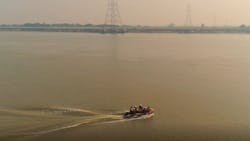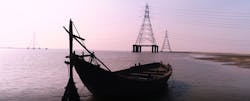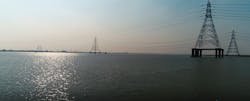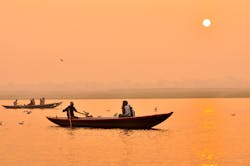The existing double-circuit 400-kVac Purnia-Bihar Shariff transmission line is a major link in the East-North Interconnection project, built by a special-purpose vehicle owned by Sterlite Power, previously Sterlite Technologies Ltd. The East-North Interconnection Co. Ltd. (ENICL) is a first-of-its-kind mega independent power transmission project undertaken by a private power transmission player in India.
The Purnia-Bihar Shariff line along with other transmission elements in the ENICL project are an important catalyst for the exchange of power between the Northeast and Eastern regions of the Indian grid. Therefore, any disruption or outages to the circuit poses major energy delivery challenges between these regions. This transmission line crosses the Ganges River, which is more than 2500 km (1550 miles) long, flowing from the Himalayas to the Bay of Bengal through some of Asia’s most densely populated regions. The crossing occurs at a place near Lakhisarai, Bihar, at a position where the width of the river required a transmission tower to be constructed in the center of the river.
Accelerated climate change has led to frequent changes to river courses and flooding, thereby increasing stress on the existing transmission infrastructure — especially the transmission towers in India. Hence, transmission lines crossing rivers must be foolproof in design and sufficiently robust to withstand climate change-related disruptions, like flash floods, high wind velocities and changes in a river’s course.
Flash floods in the Ganges River from August 2018 to September 2018 washed away transmission towers and exposed transmission tower footings, causing an outage to the Purnia-Bihar Shariff transmission line. The circuit outage lasted almost one and a half years, despite multiple attempts to restore the failed connection. Finally, Sterlite Power took up the challenge to redesign and reconstruct this critical power corridor at the Ganges River transmission line crossing using an innovative yet cost-effective solution.
Ganges River Crossing
To restore the line through conventional methods would have required massive expenditure. At the design stage, the idea of constructing the transmission tower pile foundations in the riverbed was almost immediately dismissed, as construction would have taken months to complete. It also would have been cost and labor intensive as well as difficult to implement smoothly because of the onset of the monsoon and rising flood levels. Equally important, it would have disturbed the delicate ecosystem of the river, on which most of the local population depends for their livelihood.
Also, the Ganges riverine ecosystem is the habitat for the national aquatic animal of India, the Ganges dolphin. Regarded as a keystone species, the Ganges dolphin is listed as endangered by the International Union for the Conservation of Nature. With this freshwater mammal and its habitat under destruction, the dolphin is an important indicator of the overall health of a riverine ecosystem. Therefore, to preserve the dolphin’s habitat, construction activities in the river had to be minimized because of the possible negative impact on the mammal’s population.
A Custom Conductor
The existing Ganges River crossing consisted of four transmission towers approximately 78 m (256 ft) high, supporting the 525-sq mm (0.81-sq inch) all-aluminum alloy conductor (AAAC) conductors in a quad-bundle configuration. Three supporting towers on one side of the river had been washed away by the floods.
Faced with these social, environmental and engineering challenges, Sterlite Power opted to take a bold approach by eliminating the need for intermediate towers. The solution comprised the construction of a single span crossing 1100 m (3610 ft) in length and a new supporting double-circuit transmission tower of similar height on one side of the river.
For this exceptionally long span, Sterlite Power developed a custom conductor — a 291-sq mm (0.45-sq inch) ACCC ULS Ganges conductor, manufactured at its Silvassa plant. The high-temperature, low-sag conductor comprises annealed trapezoidal-shaped aluminum wires stranded on an ultralow-sag carbon-composite core. The core was sourced from CTC Global. The conductor’s low weight helped to minimize tension on the supporting towers.
Active Water Channel
The Ganges River Crossing project had to be executed across an active water channel, so men, machines and materials had to be moved on floating barges and ferries. This exercise required careful selection of floating barges based on their load-carrying capability to ensure they could transport heavy materials. Special care was taken to ensure distributed loading on the barges.
Heavy cranes for lifting machinery were dismantled and loaded onto ferries headed to the work site, where they were unloaded and reassembled. Construction work commenced on floating platforms and at considerable heights, where even the smallest mistake could prove costly. The field teams had to think on their feet, quickly adapting solutions as they went along. For safety, site work had to be shut down when wind speeds came close to approximately 13 m/sec (43 ft/sec).
All construction workers had to be specially trained before they were allowed to climb and work at heights, because of the distractions created by the movement of the active water channel below. The river water level was actively monitored 10 km (6.2 miles) upstream of the work site, so an alarm could be raised in case of an emergency, allowing sufficient time to ensure the safety of all workers on-site.
Given the excessively long span of 1.1 km (3610 ft) and because of the heavy fog prevalent on some days, the other side of the riverbank and tower often remained invisible throughout the workday, so most of the communication had to be undertaken with the assistance of mobile communication equipment.
Meanwhile, to handle the brand-new conductor, Sterlite Power also designed new tools, hardware and accessories. Multiple teams were engaged in this project, working in unison day and night to meet challenges head on, maintaining responsibility for the heavy marine equipment and, simultaneously, executing the conductor stringing for one of the longest spans in India.
High Safety Standards
In compliance with best practices, high safety standards were maintained throughout the project despite the risky conditions. All boats were well equipped with first aid kits, life jackets and other safety equipment. Specialized training sessions on risk awareness and mitigation designed to work across river crossings were held daily, while rescue boats and professional divers were on standby in the event of an emergency.
Wind speeds and water flow rates were measured every hour, and an environment health and safety team also closely monitored the safety procedures adopted for the movement of men and materials.
Highlights and Challenges
Execution of this project involved significant collaboration, process and product innovation. Following are highlights of the project:
- A custom high-performance conductor was developed to support an especially long span, without the need for intermediate towers in between.
- No significant changes were made to the superstructure and towers, hence there were economic benefits associated with this restoration work.
- The new conductor allows an increased high-flood-level clearance of 24.3 m (80 ft) compared with the specified requirement of 22.4 m (74 ft).
- Maintenance is reduced, as there is no rust, corrosion or electrolysis with aluminum conductors and components.
- The project saved on right-of-way (RoW) space, as the existing tower locations were bypassed. The project was completed even with the space constraints of having to position heavy machinery along the riverbanks giving way due to flooding.
In addition to these highlights, the project had its share of challenges. One of the distinguishing features was the extremely challenging environment of the river crossing, above which an excessively long span of overhead line conductor had to be strung:
- Lack of roads to transport men and materials to the site, leading to the use of barges and steamers
- Flood-prone area because of the constant meandering of the Ganges River in the plains area
- Subcontractor management, with the danger of men and material falling into the river
- Material transport and storage in wet conditions
- Safety and quality-related training of the workforce on how to work in riverine conditions
- Weather elements like high wind speed in the plains, water level monitoring and response to contingencies.
Despite all these challenges, the Purnia-Bihar Shariff transmission line project was finished ahead of schedule with zero lost time due to injuries.
Recharged Corridor
This custom conductor solution will transform the way excessively long spans are built for transmission lines crossing rivers or in mountainous and hilly terrain, without the need for intermediate towers in between for support. It can help utilities to build projects faster, safer and at lower costs.
The critical Purnia-Bihar Shariff power corridor was recharged in December 2019, and the project was completed within a three-month time frame and on budget.
Manish Agarwal is a Harvard alumnus and also holds a degree in engineering. His 25-year career started in telecoms, leading the company to become a market leader in India and international markets before joining Sterlite Power. Currently, he is Sterlite Power’s CEO, responsible for Infrastructure and engineering, procurement and construction services as well as the power products business. Agarwal is credited with transforming the way electrical infrastructure, both greenfield and brownfield, is built in India. He is a leading voice on key industry issues, shaping policy priorities on trade and sustainability, and an advocate of modern and innovative technology. He is chairman of the task force on transmission at the Associated Chambers of Commerce and Industry of India, vice president of CIGRE India, a member of the National Executive Council of IEEMA, a member of the Federation of India Chambers of Commerce and Industry power committee and vice president of the Cable and Conductor Manufacturers Association of India.
For More Information
CTC Global | www.ctcglobal.com
Sterlite Power | www.sterlitepower.com
About the Author
Manish Agarwal
Manish Agarwal ([email protected]) is a Harvard alumnus and also holds a degree in engineering. His 25-year career started in telecoms, leading the company to become a market leader in India and international markets before joining Sterlite Power. Currently, he is Sterlite Power’s CEO, responsible for Infrastructure and engineering, procurement and construction services as well as the power products business. Agarwal is credited with transforming the way electrical infrastructure, both greenfield and brownfield, is built in India. He is a leading voice on key industry issues, shaping policy priorities on trade and sustainability, and an advocate of modern and innovative technology. He is chairman of the task force on transmission at the Associated Chambers of Commerce and Industry of India, vice president of CIGRE India, a member of the National Executive Council of IEEMA, a member of the Federation of India Chambers of Commerce and Industry power committee and vice president of the Cable and Conductor Manufacturers Association of India.





